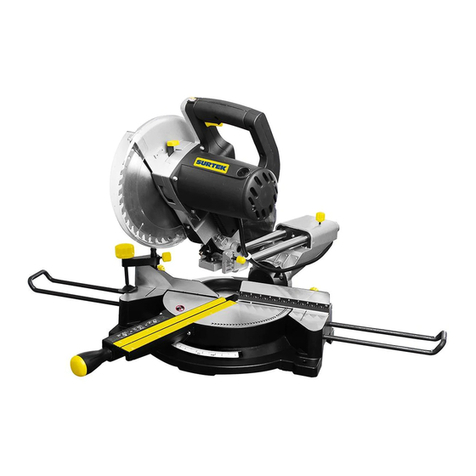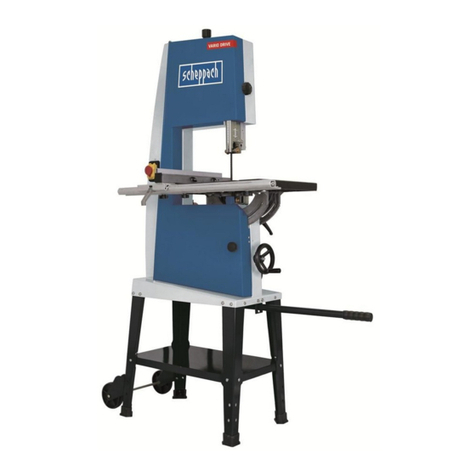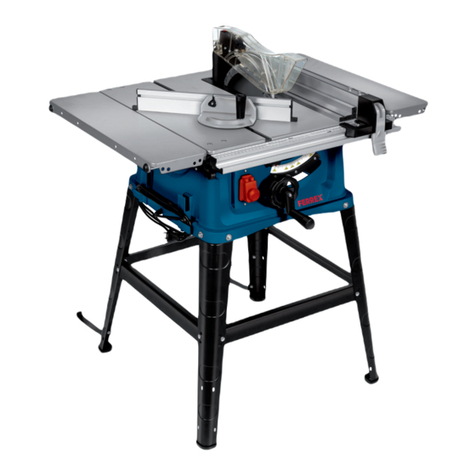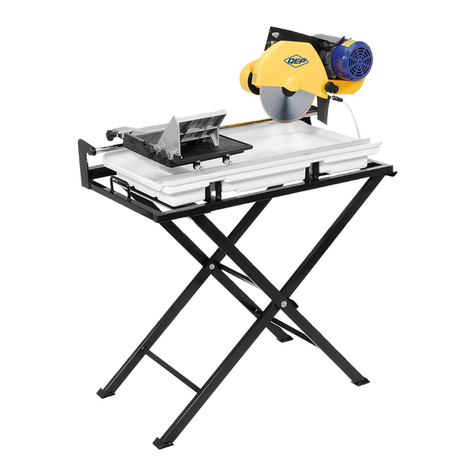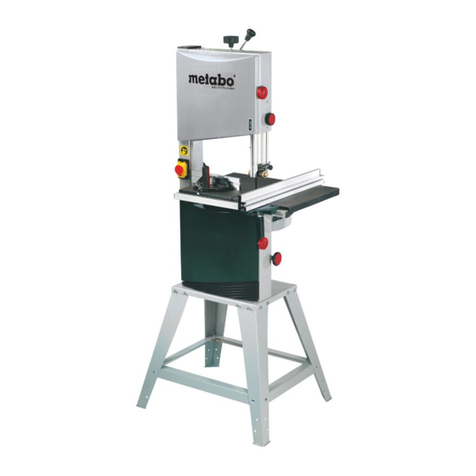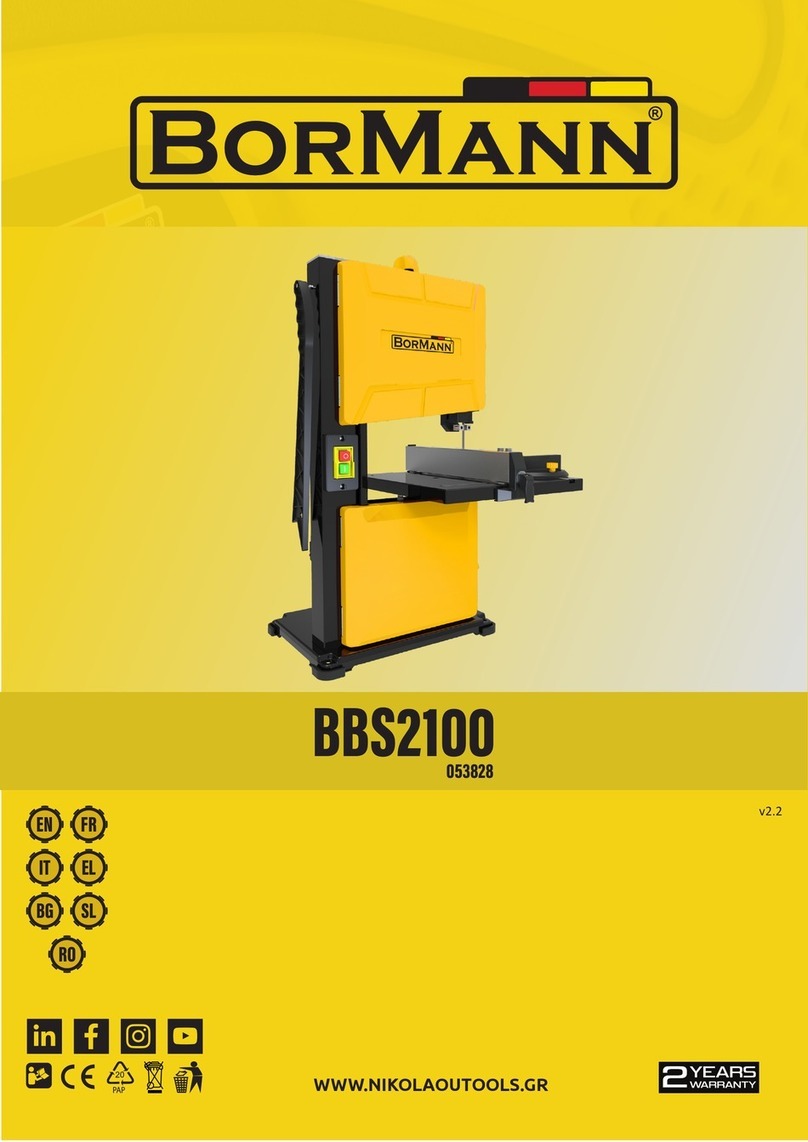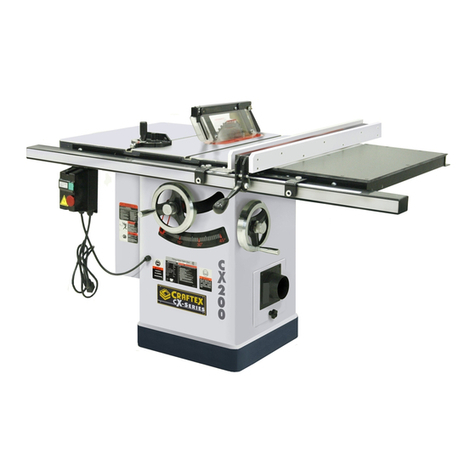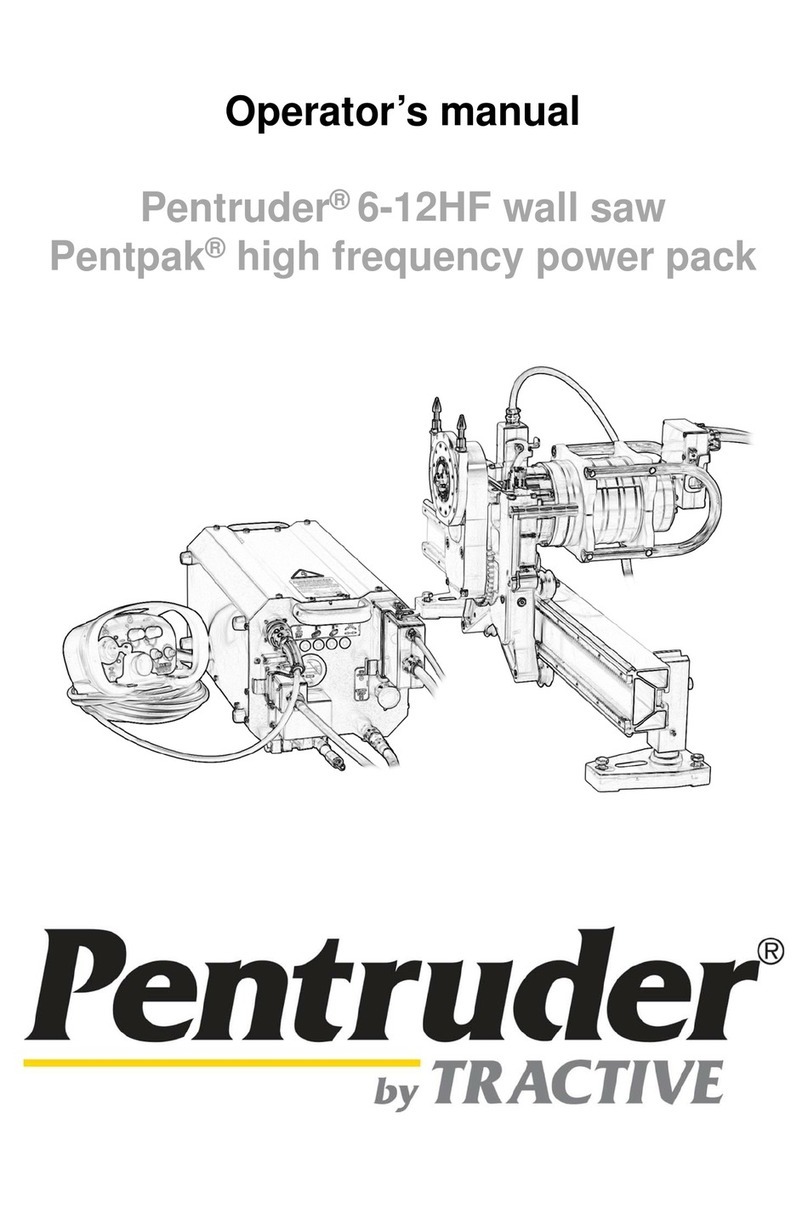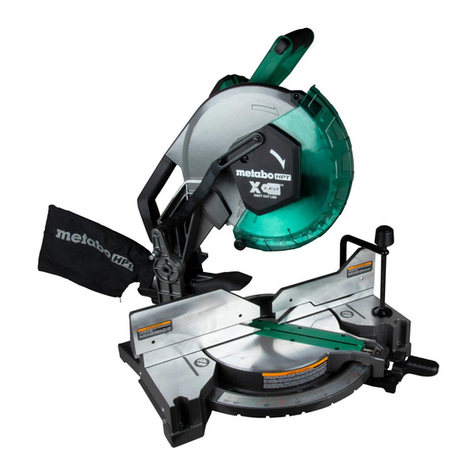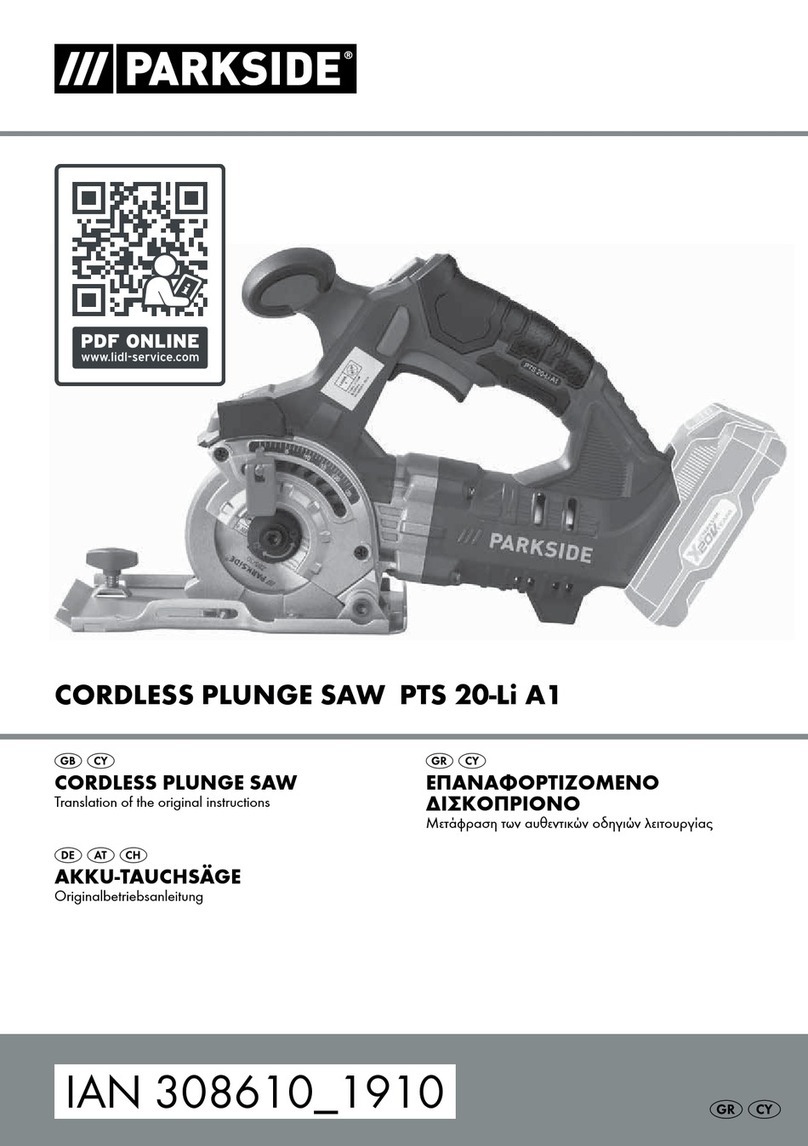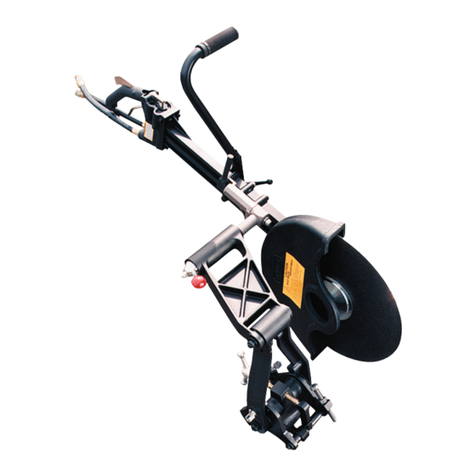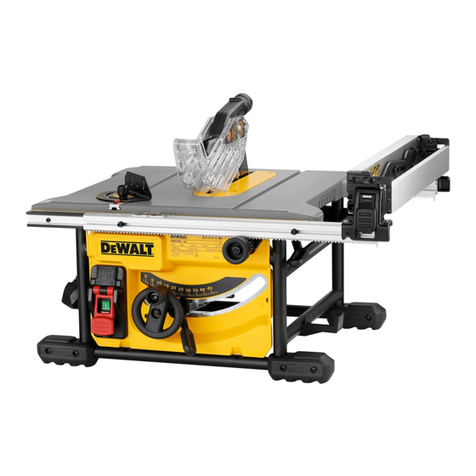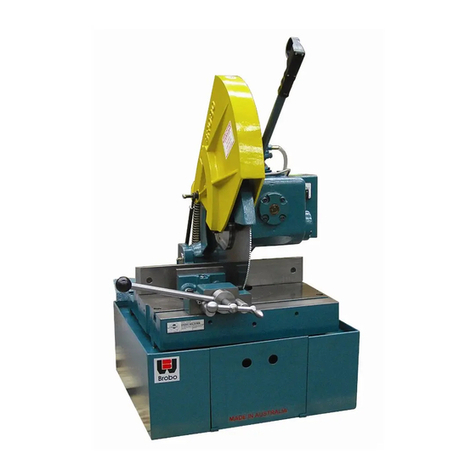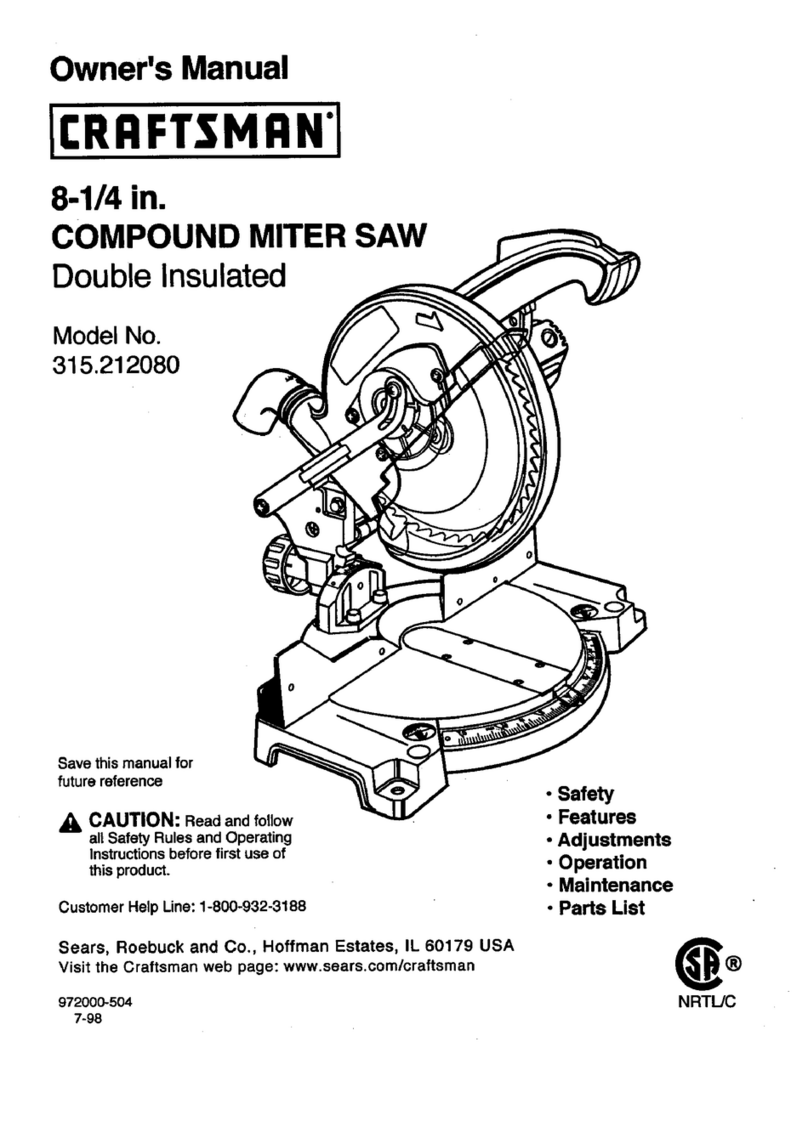Surtek CM512 Dimensions and installation guide

CM512
Sierra Cinta para Metales
Metal Band Saw
Manual de Usuario y Garantía.
User’s Manual and Warranty.
ATENCIÓN: Lea, entienda y siga las instrucciones de seguridad contenidas en este
manual antes de operar esta herramienta.
WARNING: Read, understand and follow the safety rules in this manual, before operating this tool.
CM512 manual.indd 1 29/06/15 16:17

2
ENGLISHESPAÑOL
General safety rules
Electric safety
Personal safety
Tool use and care
Specific safety rules for
metal band saws
Assembly and adjustments
Maintenance
Technical data
Notes
Warranty policy
Normas generales de seguridad
Seguridad eléctrica
Seguridad personal
Utilización y cuidados de las
herramientas eléctricas
Advertencias de seguridad para
sierras cinta para metales
Ensamble y ajustes
Mantenimiento
Especificaciones técnicas
Notas
Garantía
11
11
11
12
12
13
17
17
18
20
3
3
3
4
5
5
9
10
18
20
CONTENIDO CONTENT
SÍMBOLOS SYMBOLS
PELIGRO, ADVERTENCIA, PRECAUCIÓN:
Indica un riesgo personal o la posibilidad
de un daño.
DANGER, CAUTION, WARNING: Indicates risk of
personal injury and/or the possibility of damage.
CM512 manual.indd 2 29/06/15 16:17

NORMAS GENERALES DE SEGURIDAD
Esta SIERRA CINTA para metales tiene caracte-
rísticas que harán su trabajo más rápido y fácil.
Seguridad, comodidad y confiabilidad fueron
previstos como prioridad para el diseño del
mismo, haciendo más fácil su operación.
ADVERTENCIA: Lea todas las advertencias
de seguridad y todas las instrucciones. La omi-
sión de alguna de las advertencias e instruccio-
nes que se enlistan a continuación puede dar
como resultado un choque eléctrico, fuego y/o
un daños serios.
CONSERVE TODAS LAS ADVERTENCIAS Y
TODAS LAS INSTRUCCIONES.
SEGURIDAD EN EL ÁREA DE TRABAJO
Mantenga el área de trabajo limpia y bien ilu-
minada. Las áreas desordenadas y oscuras pro-
vocan accidentes.
No maneje herramientas eléctricas en atmós-
feras explosivas, tales como en presencia de
líquidos inflamables, gases o polvo. Las herra-
mientas eléctricas crean chispas que pueden
encender el polvo o los humos.
Mantenga alejados a los niños y curiosos
mientras maneja una herramienta eléctrica.
Las distracciones pueden causarle la pérdida
del control.
SEGURIDAD ELÉCTRICA
La clavija de la herramienta eléctrica debe
coincidir con receptáculo. No modificar nunca
la clavija de ninguna manera. No usar ningún
adaptador de clavijas con herramientas eléctri-
cas puestas a tierra. Clavijas no modificadas y
bases coincidentes reducirán el riesgo de cho-
que eléctrico.
Evite el contacto del cuerpo con superficies
puestas a tierra como tuberías, radiadores, co-
cinas eléctricas y refrigeradores. Hay un riesgo
aumentado de choque eléctrico si su cuerpo
está puesto a tierra.
No exponga las herramientas eléctricas a la llu-
via o a condiciones de humedad. El agua que
entre en la herramienta aumentará el riesgo
de choque eléctrico.
No abuse del cable. No usar nunca el cable para
llevar, levantar o desenchufar la herramienta
eléctrica. Mantenga el cable lejos del calor,
aceite, cantos vivos o piezas en movimiento.
Los cables dañados o enredados aumentan el
riesgo de choque eléctrico.
Cuando maneje una herramienta eléctrica en
el exterior, use una prolongación de cable ade-
cuada para uso en el exterior. El uso de una
prolongación de cable adecuada para uso en el
exterior reduce el riesgo de choque eléctrico.
“ESTA HERRAMIENTA CUENTA CON UN
SUJETACABLE TIPO “Y“, EN CASO DE DAÑAR-
SE EL CORDÓN DE ALIMENTACIÓN, ÉSTE DE-
BERÁ SER REEMPLAZADO POR EL FABRICANTE,
SUS CENTROS DE SERVICIO AUTORIZADOS, O
PERSONAL CALIFICADO A FIN DE EVITAR RIES-
GOS.”
EXTENSIONES DE CABLE
NOTA: El uso de cables dañados incrementa el
riesgo de descargas eléctricas o quemaduras.
Si es necesario un cable de extensión, debe ser
usado un cable con el tamaño adecuado de los
conductores. La tabla de la siguiente página,
muestra el tamaño correcto para usar depen-
diendo en la longitud del cable y el rango de
amperaje especificado en la etiqueta de valo-
res nominales del producto. Si está en duda,
use el rango próximo más grande.
Siempre use cables de extensión listados en UL,
CSA ó NOM.
TAMAÑOS RECOMENDADOS DE EXTENSIONES
DE CABLE:
Cuando esté usando el producto afuera, use
una extensión para exteriores marcadas con lo
siguiente: “WA” o “W”. Estas extensiones están
pensadas para trabajar en exteriores y reducen
el riesgo de descarga eléctrica.
SEGURIDAD PERSONAL
Esté alerta, vigile lo que está haciendo y use el
sentido común cuando maneje una herramien-
ta eléctrica. No use una herramienta eléctrica
cuando esté cansado o bajo la influencia de
ESPAÑOL•Manual de Usuario
3
CM512 manual.indd 3 29/06/15 16:17

drogas, alcohol o medicamentos. Un momento
de distracción mientras maneja herramientas
eléctricas puede causar un daño personal serio.
Use equipo de seguridad. Lleve siempre pro-
tección para los ojos. La utilización para las
condiciones apropiadas de un equipo de segu-
ridad tal como mascarilla anti-polvo, zapatos
no resbaladizos, gorro duro, o protección para
los oídos reducirá los daños personales.
Evite un arranque accidental. Asegúrese de
que el interruptor está en posición apagado
antes de conectar a la red y/o a la batería, co-
ger o transportar la herramienta. Transportar
herramientas eléctricas con el dedo sobre el
interruptor o enchufar herramientas eléctricas
que tienen en interruptor en posición encendi-
do invita a accidentes.
Retire llaves o herramienta antes de arrancar
la herramienta eléctrica. Una llave o herra-
mienta dejada unida a una pieza rotativa de
una herramienta eléctrica puede causar un
daño personal.
No se sobrepase. Mantenga los pies bien asen-
tados sobre el suelo y conserve el equilibrio en
todo momento. Esto permite un mejor control
de la herramienta eléctrica en situaciones in-
esperadas.
Vista adecuadamente. No vista ropa suelta o
joyas. Mantenga su pelo, su ropa y guantes
alejados de las piezas en movimiento. La ropa
suelta, las joyas o el pelo largo pueden ser co-
gidos en las piezas en movimiento.
Si hay dispositivos para la conexión de medios
de extracción y recolección de polvo, asegúre-
se de que éstos estén conectados y se usen co-
rrectamente. El uso de estos dispositivos puede
reducir los peligros relacionados con el polvo.
IMPORTANTE: Este aparato no se destina
para utilizarse por personas (incluyendo niños)
cuyas capacidades físicas, sensoriales o menta-
les sean diferentes o estén reducidas, o carez-
can de experiencia o conocimiento, a menos
que dichas personas reciban una supervisión o
capacitación para el funcionamiento del apa-
rato por una persona responsable de su segu-
ridad. Los niños deben supervisarse para ase-
gurar que ellos no empleen los aparatos como
juguete.
UTILIZACIÓN Y CUIDADOS DE LAS
HERRAMIENTAS ELÉCTRICAS
No fuerce la herramienta eléctrica. Use la he-
rramienta eléctrica correcta para su aplicación.
La herramienta eléctrica correcta hará el tra-
bajo mejor y más seguro al ritmo para la que
fue concebida.
No use la herramienta eléctrica si el interrup-
tor no gira “encendido” y “apagado”. Cual-
quier herramienta eléctrica que no pueda con-
trolarse con el interruptor es peligrosa y debe
repararse.
Desenchufe la clavija de la fuente de alimen-
tación y/o de la batería antes de efectuar
cualquier ajuste, cambio de accesorios, o de
almacenar las herramientas eléctricas. Tales
medidas preventivas de seguridad reducen el
riesgo de arrancar la herramienta accidental-
mente.
Almacene las herramientas eléctricas inactivas
fuera del alcance de los niños y no permita el
manejo de la herramienta eléctrica a personas
no familiarizadas con las herramientas o con
estas instrucciones. Las herramientas eléctricas
son peligrosas en manos de usuarios no entre-
nados.
Mantenga las herramientas eléctricas. Com-
pruebe que las partes móviles no estén des-
alineadas o trabadas, que no haya piezas ro-
tas u otras condiciones que puedan afectar la
operación de las herramientas eléctricas. Las
herramientas eléctricas se reparan antes de su
uso, cuando están dañadas. Muchos acciden-
tes son causados por herramientas eléctricas
pobremente mantenidas.
Mantenga las herramientas de corte afiladas y
limpias. Las herramientas de corte mantenidas
correctamente con los bordes de corte afilados
son menos probables de trabarse y más fáciles
de controlar.
Use la herramienta eléctrica, accesorios y pun-
tas de herramienta, etc. de acuerdo con estas
instrucciones y de la manera prevista para el
tipo particular de herramienta eléctrica, te-
niendo en cuenta las condiciones de trabajo
y el trabajo a desarrollar. El uso de la herra-
mienta eléctrica para aplicaciones diferentes
de las previstas podría causar una situación de
peligro.
4
CM512 manual.indd 4 29/06/15 16:17

SERVICIO
Haga revisar su herramienta eléctrica por un
servicio de reparación calificado usando sola-
mente piezas de reemplazo idénticas. Esto ga-
rantizará que la seguridad de la herramienta
eléctrica se mantiene.
ADVERTENCIAS DE SEGURIDAD PARA
SIERRAS CINTA PARA METALES
IMPORTANTE: Este manual fue hecho con
la intención de que usted se familiarice con las
partes técnicas de esta máquina. Con este ma-
nual no puede entrenarlo en su uso.
• Utilice siempre equipo de seguridad como
lentes y careta mientras usa esta máquina.
• Asegúrese de que esta herramienta se en-
cuentra propiamente posicionada en el piso
antes de conectarla.
• Antes de su operación, quítese cualquier
objeto o prenda que pueda estorbarle al mo-
mento de operar la máquina. No es necesario
utilizar guantes.
• Mantenga el piso y alrededor de la máquina
limpio y libre de virutas y aceite.
• Mantenga las guardas de la máquina en su
lugar en todo momento cuando opere. De ser
necesario quitarlas por mantenimiento, tenga
cuidado y reemplácelas de inmediato.
• Asegúrese de que el interruptor este en po-
sición de apagado (OFF) antes de conectar la
máquina a la fuente de poder.
• Mantenga una completa atención mientras
opere. Al ver a su alrededor, mantener una
conversación y cualquier otro tipo de distrac-
ción puede resultar en una lesión grave.
• Mantenga a las personas, niños y animales a
una distancia segura del área de trabajo.
• Nunca trate de hacer cualquier ajuste o al-
guna operación si no está seguro de poder
realizarlo.
• Mantenga sus dedos a cierta distancia de la
sierra de banda durante la operación.
• Cuando la Sierra cinta este en modo horizon-
tal no trate de trabajar con la pieza de trabajo
en mano. Utilice siempre el tornillo de banco y
asegure la pieza de trabajo.
• Mantenga las guardas y cubiertas en su lugar
y con un buen funcionamiento.
• Nunca fuerce la acción de corte.
• Nunca trate de realizar algún ajuste o quitar
alguna parte durante la operación.
• Siempre mantenga un soporte adecuado
para materiales muy largos o muy pesados.
• Siempre utilice partes idénticas cuando le de
mantenimiento.
• Lea y entienda todas las instrucciones y reglas
de seguridad indicadas en este manual.
• El no seguir con las indicaciones y reglas po-
drían causar daños serios.
• El uso de herramientas tales como lijadoras,
sierras, esmeriladoras, rotomartillos y otras ac-
tividades o herramientas de construcción pue-
den generar o emitir polvos con químicos que
pueden ser dañinos y causar problemas respi-
ratorios graves y permanentes u otros tipos de
lesiones.
• El riesgo de estas exposiciones depende del
uso continuo de estos elementos. Para reducir
el riesgo que producen estos químicos, trabaje
en un área bien ventilada.
ENSAMBLE Y AJUSTES
DESEMBALAJE Y LIMPIEZA
NOTA: Lea y entienda este manual por completo
antes de intentar armar u operar la máquina.
1. Saque todos los elementos del empaque de
la máquina.
2. Inspeccione y verifique el contenido que las
partes no estén dañadas o que no falte ele-
mento alguno.
3. Con un trapo limpio quite el exceso de aceite
contra oxido de la mesa y el tornillo de banco.
4. No deseche el empaque del producto hasta
que la sierra cinta haya sido ensamblada y este
funcionando correctamente.
Herramientas requeridas para el Ensamble
• Llave de 12 mm - 14 mm
• Destornillador de cruz #2
• Llaves ajustables de 6”- 8”
• Tenaza - Regular o Alicate
• Llave hexagonal de 4 mm
INSTRUCCIONES DE ENSAMBLE
ENSAMBLADO DE LAS PATAS DE LA MESA
1. Con la ayuda de otra persona voltee la sierra
cinta de tal manera que la mesa descanse sobre
el arco y el motor (Fig. 1). Colóquelo sobre un
cartón u otra superficie para que la herramien-
ta no se dañe.
2. Coloque una abrazadera en la mesa del lado
del motor (A, Fig. 1) utilizando tornillos hexa-
5
ESPAÑOL•Manual de Usuario
CM512 manual.indd 5 29/06/15 16:17

6
gonales y sus arandelas, asegúrelas con tuercas
hexagonales.
NOTA: Ajuste la tuerca en el otro lado de la
mesa (B. Fig. 1) seguido de los demás tornillos.
3. Coloque una de las patas en su lugar e ins-
tálela con los tornillos, tuercas y arandelas que
encontró en el empaque.
4. Quite la abrazadera del extremo opuesto de
la base utilizando una llave 10 mm (C, Fig. 1).
ENSAMBLE DE LAS RUEDAS Y MANIJA
1. Coloque el eje (A, Fig.
2) en su lugar y asegúre-
lo en las patas. Coloque
los tornillos (B, Fig. 2)
en ambos lados de las
ruedas y colóquelos en
el eje.
Asegure las ruedas con
tornillos (C, Fig. 2).
2. Con cuidado endere-
ce la sierra en su base
y ajuste las patas para
que la mesa esté nive-
lada.
3. Incruste la manija (A,
Fig. 3) en los hoyos que
se encuentran en las patas en la parte opuesta
de las llantas, asegúrelas con pines.
INSTALACIÓN DE LA BANDA
NOTA: COLOQUE LA SIERRA EN MODO HORI-
ZONTAL
1. Abra la cubierta (A, Fig. 4) que se encuentra
a un lado del motor y que oculta las poleas.
2. Afloje el tornillo (B,
Fig. 4,1) para que pue-
da mover con facilidad
el motor. Levante el
motor con una mano y
con la otra coloque la
banda (C, Fig. 4) en am-
bas poleas.
3. Tensione la banda, primero haga presión al
motor y ajuste el tornillo (B, Fig. 4,1) hasta que
su dedo haga una curva entre las dos poleas
de aproximadamente 1/2” de tensión. Cierre la
cubierta de las poleas.
IMPORTANTE: No sobre tensione la banda.
INSTALANDO LA BARRA
DE TOPE Y EL VOLANTE
1. Inserte la barra de tope
(A, Fig. 5) en la mesa y ase-
gúrela con el tornillo (B,
Fig. 5). Inserte el tope (C,
Fig. 5) en la barra y atorní-
llelo (D, Fig. 5) para colo-
carlo en su lugar.
2. Instale el volante (E, Fig.
6) en el eje y asegúrelo
con el juego de tornillo (F,
Fig. 6). El tornillo debe de
ser instalado en la parte
plana del eje.
ENSAMBLE DE LA MESA PARA CORTES EN
MODO VERTICAL
NOTA: Estos pasos son especificos para el uso
de la sierra de banda en modo vertical.
ADVERTENCIA: Desconecte la sierra de
banda de la fuente de poder antes de realizar
cualquier tipo de mantenimiento o ajuste. El
hacer caso omiso de esta recomendación pue-
de resultar en daños severos al usuario.
1. Desconecte la herramienta de la fuente de
poder.
2. Levante el brazo para posicionarlo en modo
vertical y asegúrelo con la palanca (A, Fig. 7).
3. Afloje el tornillo (B, Fig. 7) y coloque el so-
porte (C, Fig. 7). Apriete el tornillo lo suficiente
para colocar el soporte en su lugar.
A
B
C
Fig.1
A
B
C
Fig. 2
A
Fig. 3
A
C
Fig. 4
Fig. 4.1
B
Fig. 6 F
E
Fig. 5
A
D
B
C
CM512 manual.indd 6 29/06/15 16:17

4. Quite los dos tornillos (D, Fig. 7) y la cubierta
de los baleros (esta parte no se muestra en la
fotografía).
5. Pase la sierra por la
rendija de la mesa (A,
Fig. 8) y colóquela en
posición, asegúrela
con los tornillos (B,
Fig. 8).
6. Sujete el sopor-te a
la mesa utilizando el
tornillo (C, Fig. 8) y la
tuerca hexagonal.
7. Apriete bien el tor-
nillo (B, Fig. 7).
CAMBIANDO LA VELOCIDAD DE LA SIERRA
1. Desconecte la máquina de la fuente de poder.
2. Coloque la sierra en modo de corte horizontal.
3. Afloje el tornillo que hace tensión en el mo-
tor (B, Fig.4,1).
4. Abra la cubierta (A, Fig. 4). Levante el motor
con una mano mientras con la otra coloque la
banda (C, Fig. 4) en la combinación deseada de
las poleas.
5. Tensione la banda mientras hace presión en
el motor y ajusta el motor en posición con el
tornillo (B, Fig. 4,1) hasta que su dedo haga
una curva entre las dos poleas de aproximada-
mente 1/2” de tensión.
6. Cierre la cubierta de las poleas y conecte a la
fuente de poder.
La regla general para la velocidad de las sierras
cinta es que entre mas duro sea el material mas
lento debe de correr la cinta. Tome de referen-
cia los siguientes puntos.
MATERIAL: Herramientas, acero inoxidable,
bujes de bronce.
Velocidad: 80 pies por metro
Polea del motor; canal PEQUEÑO / Polea de la
sierra; canal GRANDE
MATERIAL: Acero con bajo contenido carbóni-
co, bronce de alta densidad.
Velocidad: 120 pies por metro
Polea del motor; canal MEDIANO / Polea de la
sierra; canal MEDIANO
MATERIAL: Bronce de baja densidad, aluminio
o cualquier otro tipo de material ligero.
Velocidad: 200 pies por metro
Polea de motor; canal GRANDE / Polea de la
sierra; canal PEQUEÑO
AJUSTANDO LAS GUÍAS DE LA SIERRA
1. Desconecte la máquina de la fuente de po-
der.
2. Afloje el tornillo hexagonal (A, Fig. 9) y des-
lice la guía de la sierra (E, Fig. 9) lo más cerca
posible de la pieza de trabajo, cuidando que
esta no interfiera con el material. Apriete el
tornillo.
3. Afloje el tornillo (C, Fig. 9) y deslice la guía
de la sierra (D, Fig. 9) lo más cercano posible,
sin interferir con el material a cortar. Aprite de
nueva cuenta el tornillo.
AJUSTANDO LA TENSIÓN DE LA SIERRA
1. Desconecte la máquina de la fuente de po-
der.
2. Abra la cubierta de la sierra y observe la posi-
ción de la sierra en la rueda. Si la sierra no esta
cerca de la pestaña de la rueda, ajuste la guía
de la sierra siguiendo los pasos de la sección
“AJUSTE DE LA GUÍA DE LA SIERRA“.
DC
B
A
Fig. 7
Fig. 8
C
B
A
B
E
D
C
A
Fig. 9
7
ESPAÑOL•Manual de Usuario
CM512 manual.indd 7 29/06/15 16:17

3. Si la sierra se encuentra junto a la orilla de
la rueda, afloje las guías (E & D, Fig. 9) y coló-
quelas lo más lejanas posible la una de la otra.
Ajústelas en su lugar.
4. Haga presión en la sierra. La presión que
ejerza con su dedo debe de causar un aproxi-
mado de 0.004” de tensión. Gire la perilla del
tensor (B, Fig. 9) hasta que alcance una tensión
adecuada. Vuelva a acomodar las guías para
adecuarlas al material de corte.
CAMBIANDO LA SIERRA CINTA
1. Desconecte la máquina de la fuente de poder.
2. Levante el brazo de la sierra hasta dejarla en
el modo de uso vertical y asegure la posición
con la palanca.
3. Abra la cubierta de la sierra quitando la perilla
que se encuentra en la parte superior del arco.
4. Quite las guardas de la sierra quitando los
tornillos.
ATENCIÓN: Es esencial que estas dos guar-
das sean instaladas después de haber colocado
la sierra cinta nueva. El no seguir con esta indi-
cación puede resultar en daños graves.
5. Quite un poco de tensión en la sierra giran-
do la perilla de tensión (B, Fig. 9), y quite la
sierra.
6. Coloque la nueva
sierra entre los bale-
ros de las guías y al
rededor de cada rue-
da. Asegúrese que los
dientes de la sierra es-
tén apuntadas hacia la
dirección correcta vea
la figura 10.
7. Vuelva a instalar las guardas y ajústelas con
los tornillos.
8. Tensione correctamente la sierra (vea la sec-
ción de “AJUSTANDO LA TENSIÓN DE LA SIE-
RRA“)
9. Coloque dos o tres gotas de aceite ligero en
la sierra.
10. Conecte la máquina a la fuente de poder.
11. Haga funcionar la sierra cinta y asegúrese
de que la sierra esté bien posicionada en la
guía (vea la sección “AJUSTE DE LA GUÍA DE LA
SIERRA“). Como una regla general, mientras
más delgada sea la pieza de trabajo a ser cor-
tada, la cantidad de dientes por pulgada debe
ser mayor. Un mínimo de tres dientes deben de
estar en contacto con la pieza de trabajo en
todo momento durante el corte de no cumplir
con esta condición se provocaran daños en el
material y en la sierra cinta.
AJUSTANDO LOS BALEROS GUÍA
1. Desconecte la máquina de la fuente de po-
der.
2. Afloje el tornillo
(A, Fig. 11) y ajuste el
conjunto (pieza com-
pleta en figura 11) de
tal manera que la par-
te de atrás del balero
este aproximadamente
a 0.002” - 0.003” de la
parte de atrás de la sie-
rra. Apriete el tornillo.
3. Afloje la tuerca (B, Fig. 11) y gire la tuerca
que se encuentra detrás del balero (C, Fig. 11)
para ajustar el balero excéntrico a un claro de
0.001”. Apriete la tuerca (B, Fig. 11).
AJUSTANDO LA GUÍA DE LA SIERRA
ADVERTENCIA: Al hacer el ajuste de la sie-
rra es necesario tener la cubierta trasera abier-
ta. Este ajuste debe de ser hecho por personal
calificado. El hacer caso omiso de esta reco-
mendación provocaría daños serios.
Un pre ajuste se ha hecho desde fábrica y no
debería ser ajustado. Si fuese necesario el ajus-
te:
1. Confirme que la sierra esté propiamente ten-
sionada. Para ajustarla, vea la sección “AJUS-
TANDO LA TENSIÓN DE LA SIERRA“.
2. Asegúrese que la sierra esté en la velocidad
más baja (vea “CAMBIANDO LA VELOCIDAD
DE LA SIERRA“).
3. Coloque la sierra en posición de modo verti-
cal y asegure la posición con la palanca.
4. Confirme nuevamente que la sierra este bien
tensionada. Vea la sección “AJUSTANDO LA
TENSIÓN DE LA SIERRA“.
5. Abra la cubierta de la sierra quitando la pe-
rilla que se encuentra en la parte superior del
arco.
6. Haga funcionar la sierra cinta y observe la
sierra. La sierra debe de girar junto a (pero no
demasiado cerca) de la orilla de la rueda.
7. Afloje los tornillos (A, Fig. 12).
Fig.11
A
B
C
Fig.10
Dirección
de corte
8
CM512 manual.indd 8 29/06/15 16:17

8. Gire el mecanismo
(B,Fig.12) mientras ob-
serva el movimiento
que hace la sierra con
respecto a la rueda.
Gire el mecanismo (B,
Fig.12) en sentido de
las manecillas del reloj
para acercarlo a la orilla de la rueda. Gire el
mecanismo en sentido contrario de las maneci-
llas del reloj para así alejarlo.
NOTA: Comience con ¼ de giro del mecanismo,
ya que este tipo de ajuste es muy sensible.
9. Una vez que ya este hecho el ajuste apriete
de nuevo los tornillos (A, Fig. 12).
AJUSTANDO LA PRESIÓN DE ALIMENTA-
CIÓN
1. Gire la manija (A, Fig. 13) en sentido de las
manecillas del reloj para disminuir la presión
del corte y al contrario de las manecillas del re-
loj para incrementar la presión.
Un buen indicativo de una buena presión de
alimentación es el color y la forma del residuo.
Si el residuo es delgado y polvorosa, incremen-
te la presión de alimentación.
Si el residuo esta quemado y pesado, disminu-
ya la presión de alimentación. Una óptima pre-
sión de alimentación ha sido establecido cuan-
do el residuo sea curvo, plateado y templado.
AJUSTANDO EL APAGADO AUTOMÁTICO
La máquina debe de detenerse cuando el corte
ha sido completado:
• Si la sierra completa el corte y continua co-
rriendo, ajuste la punta para detener la máqui-
na (A, Fig.14).
• Si la sierra se apaga antes de terminar el cor-
te ajuste la punta para detener la máquina (A,
Fig. 14).
• Si la sierra se detiene al hacer el corte y con-
tinua funcionando, ajuste el tornillo de deten-
ción de la máquina (B, Fig. 13). La sierra esta
ajustada apropiadamente cuando la sierra se
apaga justo al terminar el corte.
AJUSTANDO EL TORNILLO DE BANCO
1. Para abrir o cerrar el tornillo de banco, utili-
ce el volante (C, Fig. 14).
2. El tornillo de banco puede ser ajustado para
realizar cortes cuadrados y de inglete. Afloje
el tornillo hexagonal y ajuste el tornillo para
el corte.
3. Ajuste las guías de la sierra para que puedan
estar lo más cercanas al material de corte.
4. En la parte de atrás de la mesa, se encuentra
una escala, esta le ayudará a ajustar cortes a
90º o a un corte de inglete en particular.
NOTA: Revise que el tornillo de banco tenga
un buen ajuste.
MANTENIMIENTO
LUBRICACIÓN
El ensamble de baleros que se encuentran en
las guías de la sierra y las ruedas de la sierra se
encuentran selladas, estas no requieren ningún
tipo de lubricación.
Lubrique el tornillo de banco y el tornillo prin-
cipal como fuera necesario (utilice un tubo #2
para engrasarlo).
Fig. 13 A
Fig. 14
A
CB
9
ESPAÑOL•Manual de Usuario
Fig.12
A
B
CM512 manual.indd 9 29/06/15 16:17

10
El aceite de la caja de engranes tiene que ser
cambiado después de 90 días de operación
(como primera lubricación). Después de esto
cambie el aceite cada 6 meses.
Para cambiar el aceite de la caja de engranes:
1. Desconecte la máquina de la fuente de
poder.
2. Coloque el bra-
zo de la sierra de
forma horizontal.
3. Quite los torni-
llos (A, Fig. 15) de
la caja de engra-
nes y quite la cu-
bierta y las juntas.
4. Coloque un contenedor debajo de la esquina
baja derecha de la caja de engranes con una
mano, mientras con la otra levante lentamente
el brazo de la sierra. Deje que todo el aceite
se vacíe.
5. Coloque de nuevo el brazo de forma hori-
zontal. Limpie el restante de la caja de engra-
nes con un trapo.
6. Llene la caja de engranes con un aproximado
de 250 ml de aceite SHC 634.
7. Reemplace las juntas y coloque la cubierta
de nuevo. Atornille la cubierta con los tornillos.
ESPECIFICACIONES TÉCNICAS
A
Fig.15
VOLTAJE-FRECUENCIA
CAPACIDAD DE CORTE
ANCHO DE CORTE
DIMENSIONES DE LA HOJA
POTENCIA
PESO
120 V ~ 60 Hz
10 mm
15 mm
1 628 x 0,64 mm x 12,6 mm
550 W
55 kg (121 lb)
CM512 manual.indd 10 29/06/15 16:17

GENERAL SAFETY RULES
Your METAL BAND SAW has many features
that will make your job faster and easier. Safe-
ty, performance and reliability have been given
top priority in the design of this tool, qualities
to make easy to maintain and to operate.
WARNING: Read and understand all in-
structions. Failure to follow all indications list-
ed below, may result in electric shock, fire and/
or serious personal injury.
SAVE THESE INSTRUCTIONS.
SAFETY IN WORKING AREA
Keep your work area clean and well lit. Clut-
tered benches and dark areas may cause acci-
dents. Do not operate power tools in explosive
atmospheres, such as in the presence of flam-
mable liquids, gases or dust. Some power tools
create sparks which may provoke fire.
Keep away observers, children and visitors
while operating a power tool. Distractions can
cause you to lose control.
ELECTRIC SAFETY
Double insulation eliminates the need for the
three wire grounded power cord and ground-
ed power supply system.
Avoid the body contact with grounded surfac-
es such as pipes, radiators and refrigerators.
There is an increased risk of electric shock if
your body is grounded.
Don’t expose power tools to rain or wet condi-
tions. The presence of water into power tools
will increase the risk of electric shock.
Do not abuse of the power cord. Never use the
power cord to carry the tool and do not pull
the plug off the outlet. Keep the cable away of
heat, oil, sharp edges or moving parts. Replace
damaged cords immediately. Damaged cords
increase the risk of electric shock.
When operating a power tool outside, use an
outdoor extension cord marked “W-A” or “W”.
These cords are rated for outdoor use and re-
duce the risk of electric shock.
EXTENSION CORDS
Replace damaged cords immediately. The use
of damaged cords can shock, burn or electric
shock. If an extension cord is necessary, a cord
with adequate size conductors should be used
to prevent excessive voltage drop, loss of pow-
er or overheating. The table below shows the
correct size to use, depending on cord length
and nameplate amperage rating of tools. In
case of doubt use the next heavier gauge. Al-
ways use UL listed extension cords.
SIZE RECOMMEND EXTENSION CABLES
PERSONAL SAFETY
Stay alert, watch what you are doing and use
common sense when operating a power tool.
Don't use the tool if you are tired or under the
influence of drugs, alcohol or medication. A
moment of inattention while operating power
tools may cause a serious personal injury.
Dress properly. Do not wear loose clothing
or jewelry. Contain long hair. Keep your hair,
clothing and gloves away of moving parts.
Loose clothes, jewelry or long hair can be
caught in moving parts.
Avoid an accidental starting. Be sure that the
switch is OFF before plugging in. Carrying
tools with the finger on the switch or plug in
the tool switch in ON may cause accidents.
Remove the adjusting keys or wrenches be-
fore turning the tool on. A wrench or a key
that is left close to a rotating part of the tool
may provoke a personal injury.
Do not overreach. Keep proper footing and
balance at all times. Proper footing and bal-
ance enables better control of the tools on un-
expected situations. Use safety equipment. Al-
ways wear eye protection. Dust mask, nonskid
safety shoes, hard hat, or hearing protection
must be used for appropriate conditions.
Before connecting the tool to a power source
(receptacle, outlet, etc.) be sure that the volt-
age supplied is the same as that one specified
on the nameplate of the tool. To use a not
specified voltage may cause a serious injury to
the user as well as damage the tool.
ENGLISH•User's manual
11
CM512 manual.indd 11 29/06/15 16:17

IMPORTANT: This appliance is not intended
for use by persons (including children) with re-
duced physical, sensory or mental capabilities
may be different or reduced, or lack of experi-
ence or knowledge, unless such persons are su-
pervised or trained to operate the product by
a person responsible for their safety. Children
should be supervised to ensure they do not use
the devices as toys.
TOOL USE AND CARE
Do not force the power tool. Use the correct
tool for the application. The correct tool will
do the job better and more safely at the rate
that it was designed to work at.
Do not use tools if switch does not turn it on
or off. Any tool that cannot be controlled with
the switch is dangerous and must be repaired.
Disconnect the plug from the power source
before making any adjustments, changing ac-
cessories or storing the tool. This preventive
safety measures reduce the risk of accidental
starting of the tool.
When the power tool is not in use, store it out
of the reach of children, and do not allow in-
dividuals who are not familiar with the power
tool or these instructions to operate it. Power
tools are dangerous in the hands on untrained
users.
Maintain the power tool. Check for misalign-
ment or binding of moving parts, broken parts,
and any other condition that may affect the
operation of the power tool. If it is damaged,
have it repaired before using. Many accidents
are caused by poorly maintained power tools.
Check for misalignment or bonding of moving
parts, breakage parts, and any other condition
that may affect the tools operation. If you find
a damaged tool, take it to service before use it.
Use only accessories that are recommended by
the manufacturer of your model. Suitable ac-
cessories for one tool, may become hazardous
when are used on another tool.
Keep cutting tools, sharpened and clean. Cut-
ting tools in good condition with sharpened
edges, are less likely to stuck in workpieces or
easier to control.
Is recommendable to use a safety device suit-
able, such a thermal and differential switch
when you are using an electric equipment.
SERVICE
Tool service must be performed only by quali-
fied repair personnel. Service or maintenance
performed by unqualified personnel could re-
sult in a risk of injury.
SPECIFIC SAFETY RULES FOR
METAL BAND SAWS
IMPORTANT: This manual is intended to fa-
miliarize you with the technical aspects of this
band saw. It is not, nor was it intended to be, a
training manual.
• Always wear approved safety glasses/face
shields while using this machine.
• Make certain the machine is properly ground-
ed before connecting.
• Before operating the machine, remove
tie, rings, watches, other jewelry, and roll up
sleeves above the elbows. Remove all loose
clothing and confine long hair. Do not wear
gloves.
• Keep the oor around the machine clean and
free of scrap material, oil and grease.
• Keep machine guards in place at all times
when the machine is in use. If removed for
maintenance purposes, use extreme caution
and replace the guards immediately.
• Make certain the switch is in the OFF position
before connecting the machine to the power
supply.
• Give your work undivided attention. Look-
ing around, carrying on a conversation, and
“horse-play” are careless acts that can result in
serious injury.
• Keep visitors a safe distance from the work
area.
• Never attempt any operation or adjustment
if the procedure is not understood.
• Keep ngers away from the blade when the
machine is running.
• Never hand hold material with the saw in the
horizontal position. Always use the vise and
clamp it securely.
• Keep belt guard and wheel covers in place
and in working order.
• Never force the cutting action.
• Do not attempt to adjust or remove tools
during operation.
• Always provide adequate support for long
and heavy material.
12
CM512 manual.indd 12 29/06/15 16:17

• Always use identical replacement parts when
servicing.
• Read and understand all warnings posted on
the machine.
• Failure to comply with all of these warnings
may cause serious injury.
• Some dust created by power sanding, sawing,
grinding, drilling and other construction activi-
ties contains chemicals known to cause cancer,
birth defects or other reproductive harm. Some
examples of these chemicals are:
· Lead from lead based paint.
· Crystalline silica from bricks and cement and
other masonry products.
· Arsenic and chromium from chemically treat-
ed lumber.
• Your risk from those exposures varies, de-
pending on how often you do this type of
work. To reduce your exposure to these chemi-
cals: work in a well ventilated area, and work
with approved safety equipment, such as those
dust masks that are specifically designed to fil-
ter out microscopic particles
UNPACKING AND ASSEMBLY
UNPACKING AND CLEAN-UP
NOTE: Read and understand the entire manual
before attempting setup or operation.
1. Remove all contents form the shipping car-
ton.
2. Inspect contents for shipping damage and
report any damage to your distributor.
3. Wipe bed and vise assembly with clean cloth
to remove excess oil used to prevent rust.
4. Do not discard any packing material until
saw has been assembled and is running prop-
erly.
Tools Required for Assembly
• Wrench 12 mm - 14 mm
• #2 Cross Point Screwdriver
• 6” - 8” Adjustable Wrench or Wrench Set
• Pliers - Regular or Needle Nose
• 4 mm Angle Hex Wrench
• Ratchet and Sockets will Speed Assembly
ASSEMBLY INSTRUCTIONS
ASSEMBLING STAND LEGS
1. With the help of another person turn the
saw over so that it rests on the motor and saw
13
ENGLISH•User's manual
bow (Figure 1). Place it on a piece of cardboard,
or a surface that will not damage the saw.
2. Attach a cross brace to the motor side
(A, Fig.1) of the bed using three hex cap bolts,
six flat washers, and secure with three hex
nuts.
NOTE: Tighten the nut on the end of the bed
(B, Fig.1) first followed by the nuts on the sides.
3. Attach a leg to the cross brace using four
carriage bolts, four flat washers and four hex
nuts. Use a 12 mm wrench to tighten. Repeat
for other leg.
4. Remove the brace (C, Fig. 1) on the oppo-
site end of the bed and bow using a 10 mm
wrench.
ASSEMBLING WHEELS AND HANDLE
1. Put the axle (A, Fig. 2)
in place and tighten to
the legs. Place the bolts
(B, Fig. 2) on both sides
of the wheels and place
on the axle. Secure
wheels with two screws
(C, Fig. 2).
2. Carefully turn the
saw onto its stand and
adjust the feet so the
bed is level.
3. Put the handle (A,
Fig. 3) through holes in
the stand legs opposite
of the wheel assembly
and secure with split
pins.
INSTALLING
V-BELT
1. Pull cover (A,
Fig. 4) around
motor shaft and
worm gear shaft.
A
B
C
Fig. 1
A
B
C
Fig. 2
A
Fig. 3
A
C
Fig. 4
CM512 manual.indd 13 29/06/15 16:17

14
2. Loosen screw (B, Fig.
4.1) to move motor
freely. Lift motor with
one hand while the oth-
er hand places V-belt (C,
Fig.4) on both pulleys.
3. Tension belt by pressing up on the motor
while tightening hex nut (B, Fig. 4.1) until
finger pressure on the belt between the two
pulleys causes approximately 1/2” deection.
Close pulley cover.
IMPORTANT: Don’t over tighten the belt.
INSTALLING STOP ROD
AND HAND WHEEL
1. Insert stop rod (A, Fig.
5) into bed and tighten set
screw (B, Fig. 5). Slide stock
stop (C, Fig. 5) onto rod
and tighten set screw (D,
Fig. 5) to hold in place.
2. Slide hand wheel (E, Fig.
6) onto shaft and secure
by tightening set screw (F,
Fig. 6). Make sure set screw
seats on flat portion of
shaft.
VERTICAL CUTTING PLATE ASSEMBLY
NOTE: These steps are only necessary when us-
ing the band saw in the vertical mode.
WARNING: Disconnect the band saw from
the power source before making any repairs or
adjustments. Failure to comply may cause seri-
ous injury!
1. Disconnect the band saw from the power source.
2. Raise the arm to the vertical position and
lock in place with lever (A, Fig. 7).
3. Loosen bolt (B, Fig. 7) and insert bracket (C,
Fig. 7). Tighten bolt just enough to hold the
bracket in place.
4. Remove two screws (D, Fig. 7) and plate.
5. Guide blade
through slot in table
(A, Fig. 8) and fasten
table with two screws
(B, Fig. 8).
6. Fasten support
bracket to underside
of table using screw
(C, Fig. 8) and hex nut.
7. Tighten bolt (B, Fig.
7).
CHANGING BLADE SPEED
1. Disconnect the machine from the power
source.
2. Place saw arm in the horizontal position.
3. Loosen tensioning plate hex nut (B, Fig.4,1).
4. Open pulley cover (A, Fig.4). Lift motor with
one hand while placing the belt (C, Fig. 4) on
the desired pulley combination.
5. Tension belt by pressing down on the mo-
tor while tightening hex nut (B, Fig.4,1) until
finger pressure on the belt between the two
pulleys causes approximately 1/2” deection.
Close pulley cover. Don’t over tighten the belt.
6. Close pulley cover and connect to power
source.
The general rule for band saw blade speed is
the harder the material being cut, the slower
the blade speed. Reference next table for a
guide to blade speed for a type of material be-
ing cut.
MATERIAL: Tool, stainless or alloy steel, bear-
ing bronzes. Speed: 80 FPM
Motor pulley; SMALL / Saw pulley; LARGE
MATERIAL: Mild steel, hard brass or bronze.
Speed: 120 FPM
Motor pulley; MEDIUM / Saw pulley; MEDIUM
MATERIAL: Soft brass, aluminum or other light
materials. Speed: 200 FPM
Motor pulley; LARGE / Saw pulley; SMALL
DC
B
A
Fig. 7
Fig. 8
C
B
A
Fig. 6 F
E
Fig. 5
A
D
B
C
Fig. 4.1
B
CM512 manual.indd 14 29/06/15 16:17

ADJUSTING BLADE GUIDES
1. Disconnect machine from the power source.
2. Loosen bolt (A, Fig. 9) and slide blade guide
assembly (E, Fig. 9), as close as, possible with-
out interference to the material being cut.
Tighten knob.
3. Loosen bolt (C, Fig. 9) and slide blade guide
assembly (D, Fig. 9), as close as, possible with-
out interference to the material being cut.
Tighten bolt
ADJUSTING BLADE TENSION
1. Disconnect machine from the power source.
2. Open blade cover and observe the position
of the blade on the wheel. If the blade is not
next to the wheel flange, adjust blade track-
ing following the steps under “Adjusting Blade
Tracking”.
3. If the blade is next to the wheel flange,
loosen the blade guide assembly lock knob and
hex head bolt (A & C, Fig.9) and slide the blade
guide assemblies as far apart as possible. Lock
in place.
4. Depress blade. Finger pressure should cause
approximately 0.004” deection. Turn blade
tension knob (B, Fig.9) until the proper ten-
sion is achieved. Re-position guides for cutting
material.
CHANGING BLADES
1. Disconnect machine from the power source.
2. Raise the saw arm to the vertical position
and lock in place with lock lever.
3. Open blade cover by removing the small
knob found on the top side of the bow.
4. Remove red blade guards by removing two
screws.
WARNING: It is essential these two guards
be installed after the new blade has been fit-
ted. Failure to comply may cause serious injury!
5. Release tension on the blade by turning ten-
sioning bolt (A, Fig.9), and remove the blade.
6. Place new blade be-
tween the blade guide
assemblies and around
each wheel. Make sure
blade teeth are point-
ing in the proper direc-
tion (Figure 10). Ten-
sion enough to hold in
place.
7. Install red blade guards with two screws.
8. Tension blade fully, see “Adjusting Blade
Tension”.
9. Place two to three drops of lightweight oil
on the blade.
10. Connect machine to the power source.
11. Run saw and make sure blade is tracking
properly, see “Adjusting Blade Tracking”. As
a general rule, the thinner the material to be
cut, the more teeth per inch on the blade. A
minimum of three teeth should be in contact
with the material at all times during the cut. If
the teeth straddle the material, severe damage
can result to the material and the blade.
ADJUSTING BLADE GUIDE BEARINGS
1. Disconnect machine
from the power source.
2. Loosen bolt (A, Fig.
11) and adjust assembly
so that back roller bear-
ing is approximately
0.002” - 0.003” from
the back of the blade.
Tighten bolt.
3. Loosen nut (B, Fig. 11) and turn nut (C, Fig.
11) to adjust eccentric bearing to a clearance of
0.001”. Tighten nut (B, Fig. 11) to lock.
4. Connect machine to power source.
ADJUSTING BLADE TRACKING
WARNING: Blade tracking adjustment re-
quires running the saw with the back cover
open. This adjustment must be completed by
qualified persons only. Failure to comply may
cause serious injury.
Fig.10
Cutting
direction
B
E
D
C
A
Fig. 9
Fig.11
A
B
C
15
ENGLISH•User's manual
CM512 manual.indd 15 29/06/15 16:17

16
Blade tracking has been set at the factory and
should not need adjustment. If blade tracking
needs to be adjusted:
1. Confirm that blade tension is set properly.
To adjust, see section titled “Adjusting Blade
Tension”.
2. Make sure the saw is in its slowest speed, see
“Changing Blade Speeds”.
3. Move saw arm to the vertical position and
lock in place with the lock lever.
4. Confirm again that blade tension is set prop-
erly. See section titled “Adjusting Blade Ten-
sion”.
5. Open blade cover by removing the knob
found on the top side of the bow.
6. Run saw and observe blade. Blade should run
next to but not tightly against wheel flange.
7. Loosen bolts (A, Fig. 12).
8. Turn set screw (B,
Fig. 12) while observ-
ing blade tracking on
wheel. Turn set screw
clockwise to track closer
to wheel flange. Turn
set screw counter-clock-
wise to track away from
the wheel flange.
NOTE: Start with ¼ turns on the set screw. The
tracking is sensitive.
9. Once tracking is set, tighten bolts (A, Fig.
12).
ADJUSTING FEED PRESSURE
1. Turn handle (A, Fig. 13) clockwise to de-
crease cutting pressure and counterclockwise
to increase cutting pressure.
A good indication of proper feed pressure is
the color and shape of the cutting chips. If the
chips are thin or powdered, increase the feed
pressure.
If the chips are burned and heavy, decrease
the feed pressure. If they are still burned
and heavy, reduce the blade speed. Optimum
feed pressure has been set when the chips are
curled, silvery, and warm.
ADJUSTING AUTOMATIC SHUT-OFF
The saw should stop after the cut has been
completed:
• If the saw completes the cut and continues to
run, adjust the stop tip (A, Fig. 14) down.
• If the saw shuts off before the cut is com-
plete, adjust the stop tip (A, Fig. 14) up.
• If the saw stops cutting but continues to run,
adjust the stop bolt (B, fig. 14) down. The saw
is properly adjusted when the saw shuts off
just after the blade has finished the cut.
ADJUSTING THE VISE
1. To open and close the vise use the hand
wheel (C, Fig. 14).
2. The vise can be adjusted for square and mi-
ter cuts. Loosen the hex cap bolts and adjust
the vise for the cut.
3. Adjust the blade guides so they are as close
as possible to the material without interfering.
4. There is a scale on the back side of the bed
to aid in setting up the vise for 90° cuts or a
particular miter.
NOTE: Always check the vise setup with a com-
bination square, against the blade and vise, so
that you can verify the vise setting is correct.
Fig. 13 A
Fig. 14
A
CB
Fig.12
A
B
CM512 manual.indd 16 29/06/15 16:17

17
ENGLISH•User's manual
MAINTENANCE
LUBRICATION
Ball bearings on the blade guide assemblies
and the blade wheels are permanently sealed
and require no lubrication. Lubricate the vise
lead screw as needed with #2 tube grease.
Gear box oil will have to be changed after 90
days of operation. There after, change every
six months.
To change the gear box oil:
1. Disconnect ma-
chine from the
power source.
2. Place saw arm
in the horizontal
position.
3. Remove screws
(A, Fig. 15) from
the gear box and
remove cover
plate and gasket.
4. Hold a container under the lower right cor-
ner of the gear box with one hand while slowly
raising the saw arm with the other. Drain com-
pletely.
5. Place arm in the horizontal position. Wipe
out remaining oil with a rag.
6. Fill gear box with approximately 1/2 pint of
MOBIL SHC 634.
7. Replace gasket and cover. Fasten cover with
bolts.
TECHNICAL DATA
A
Fig.15
VOLTAGE-FREQUENCY
CUTTING CAPACITY
CUTTING WIDTH
BLADE DIMENSIONS
POWER
WEIGHT
120 V ~ 60 Hz
10 mm
15 mm
1 628 x 0,64 mm x 12,6 mm
550 W
55 kg (121 lb)
CM512 manual.indd 17 29/06/15 16:17

18
Notas / Notes
CM512 manual.indd 18 29/06/15 16:17

19
Manual de usuario / User’s manual
Notas / Notes
CM512 manual.indd 19 29/06/15 16:17

CM512
20
ESPAÑOL
PÓLIZA DE GARANTÍA
ENGLISH
WARRANT POLICY
Urrea Herramientas Profesionales S.A. de C.V.
Warranties this product for a period of 1 year in
its parts, components and manual labour against
any manufacture defect from the purchasing date.
Purchase date: ____/____/____
Product:____________________
Brand:______________________
Model:______________________
______________________________
Distributor seal and signature
Sold and Imported by:
Urrea Herramientas Profesionales S.A. de C.V.
km 11,5 Carretera A El Castillo, El Salto, Jalis-
co, México. C. P. 45680, Tel. (33) 3208 7900,
RFC UHP900402Q29
Terms:
In order to make warranty effective you must pres-
ent the product along with the warranty properly
fillled and signed to an authorized distributor or
service center.
Urrea Herramientas Profesionales S.A. de C.V.
will cover the transportation cost related to the
warranty.
This warranty is not applicable in the follow-
ing cases:
· When the product has not been used according
to normal conditions or natural wear of its parts.
· When the product has not been used according
with this user’s manual instructions.
· When the product has been fixed or modified by
unauthorized or unqualified person.
Urrea Herramientas Profesionales S.A. de C.V.
garantiza este producto por el termino de 1 año
en sus piezas, componentes y mano de obra con-
tra cualquier defecto de fabricación a partir de la
fecha de entrega.
Fecha de venta: ____/____/____
Producto: ___________________
Marca: ______________________
Modelo: ____________________
______________________________
Sello y firma de distribuidor
Comercializado e Importado por:
Urrea Herramientas Profesionales S.A. de C.V.
km 11,5 Carretera A El Castillo, El Salto, Ja-
lisco, México. C. P. 45680, Tel. (33) 3208 7900,
RFC UHP900402Q29
Condiciones:
Para hacer efectiva la garantía deberá presentar
el producto junto con la póliza de garantía debi-
damente firmada y sellada por el establecimiento
donde la adquirió, en cualquiera de los centros de
servicio autorizados.
Los gastos de transportación que se deriven del
cumplimiento de la garantía serán cubiertos por:
Urrea Herramientas Profesionales S.A. de C.V.
Esta garantía no será valida en los siguientes
casos:
· Cuando el producto haya sido utilizado en condi-
ciones distintas a las normales o al desgaste natu-
ral de sus partes.
· Cuando el producto no haya sido operado de
acuerdo al instructivo de uso que lo acompaña.
· Cuando el producto haya sido alterado o repara-
do por personas no autorizadas.
CM512 manual.indd 20 29/06/15 16:17
Table of contents
Languages:
Other Surtek Saw manuals

Surtek
Surtek SB714 Dimensions and installation guide
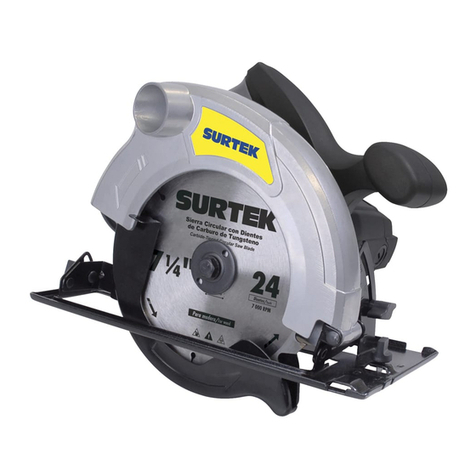
Surtek
Surtek SC707A User manual
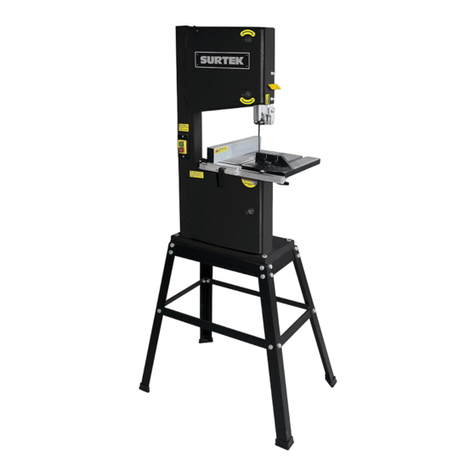
Surtek
Surtek SB710 Dimensions and installation guide
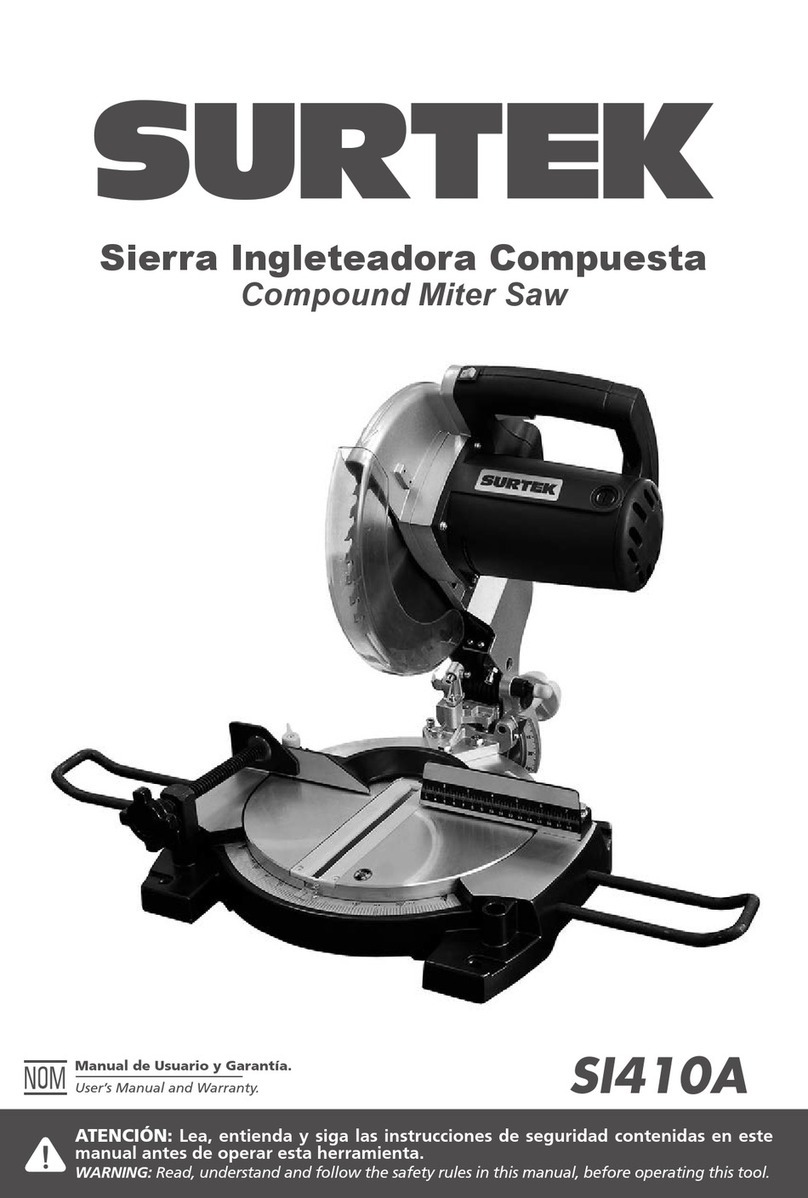
Surtek
Surtek SI410A User manual
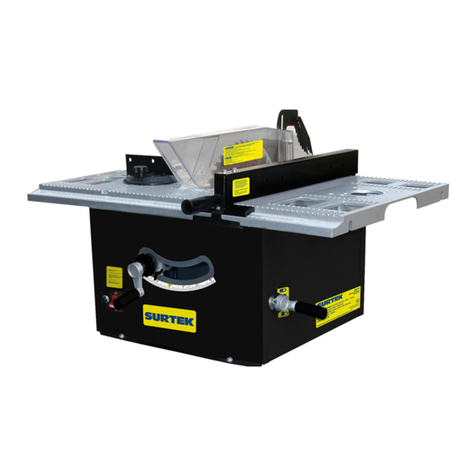
Surtek
Surtek SM710 Dimensions and installation guide
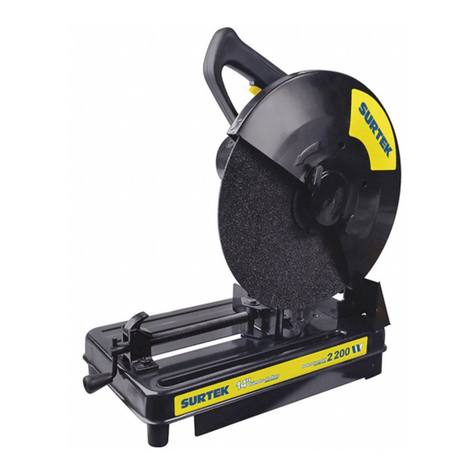
Surtek
Surtek CM714A User manual
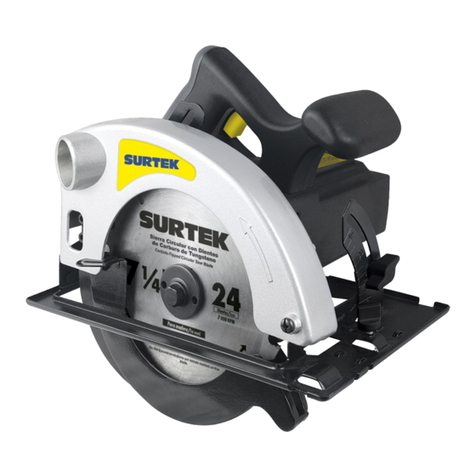
Surtek
Surtek SC407C Dimensions and installation guide
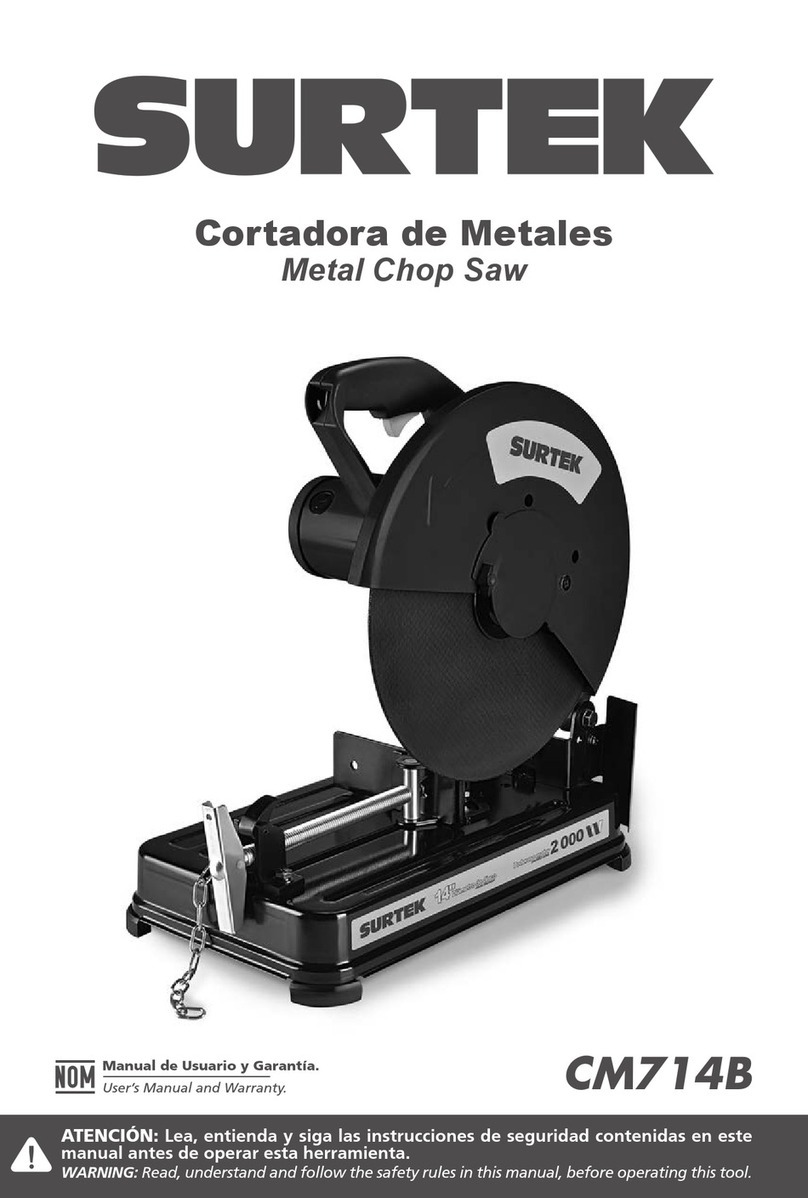
Surtek
Surtek CM714B Dimensions and installation guide
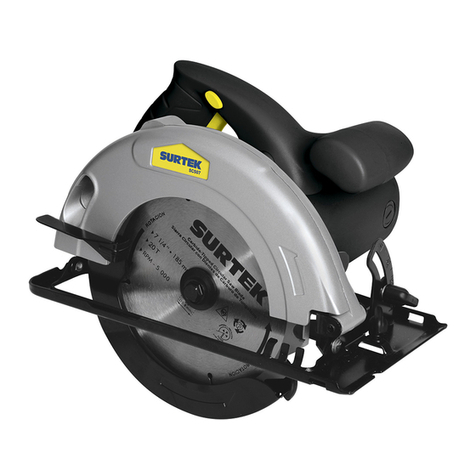
Surtek
Surtek SC507 User manual
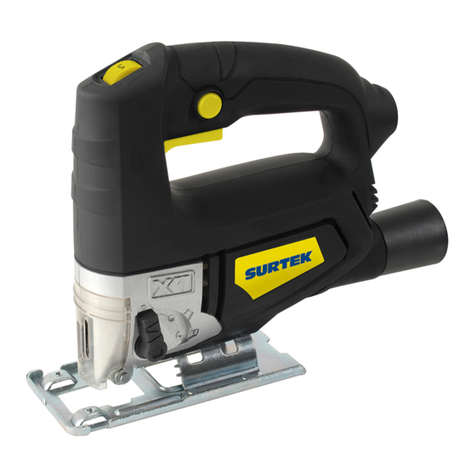
Surtek
Surtek SK403C Dimensions and installation guide
